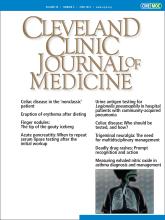
Celiac disease (CD) is an immune disorder that is dependent upon the presence of ingested gluten to drive the disruption of mucosal integrity, resulting in manifestations of malabsorption. The expression of the disorder differs somewhat in childhood (greater degree of classic malabsorption) than in adulthood, where the attributed manifestations are far more heterogeneous, and some are controversial as to their direct relationship with the underlying pathophysiology. The classic characteristics of the disorder respond completely over time to prolonged complete abstinence from ingested gluten, although a true minority (< 2%) have “refractory” celiac disease, for which there is a clinically important differential diagnosis.1 The dramatic efficacy of gluten avoidance in treating classic (autoimmune) gastrointestinal CD, coupled with increasing community awareness of the gut microbiome as a potential contributor to the pathophysiology of multiple disorders, has led to a cultlike acceptance of gluten avoidance as a potential panacea for all things autoimmune.
Patients who test convincingly positive for CD (although as noted by Nasser et al2 in this issue of the Journal, there is no true gold standard for diagnosis) can expect relief of malabsorptive symptoms and normalization of their anti-tissue transglutaminase antibody test and duodenal histology if they maintain a strict gluten-free diet (GFD). Some extraintestinal manifestations of CD such as otherwise unexplained iron deficiency should also resolve, as iron deficiency may be a direct effect of the disrupted intestinal mucosa. Interestingly, CD has been offered as an explanation for nearly 4% of cryptogenic increases in level of aspartate aminotransferase or alanine aminotransferase, or both.3 In 1 of several studies, after a thorough unrevealing evaluation for etiology, the unexplained aminotransferase elevation normalized in 4 out of 5 patients within 6 months of adherence to a GFD.4
As Nasser et al note, perhaps 1% of the general population may have CD, with most being untested and undiagnosed at least in part due to the absence of “classic” symptoms. They endorse consideration of testing of patients with several “nonclassical signs and symptoms of CD,” although they also note that “symptomatic improvement on a gluten-free diet has a diagnostic precision as low as 30%.”2 I understand their perspective, and if a seemingly benign treatment option supported by the presence of positive laboratory test results provides an explanation and a therapeutic option for confusing and chronic symptoms, is there a downside? Many patients are trying some version of a GFD on their own initiative anyway, although meticulous adherence is likely rare.
In my general rheumatology clinic, in patients with unexplained malaise, fatigue, and polyarthralgia, the only gastrointestinal issue as common as irritable bowel syndrome is concern for possible gluten sensitivity. If it were easy to accomplish, a trial of a GFD could be offered to all these patients, with or without minimal or full testing for CD. Some clinicians in my institution are seemingly taking this approach. But there are costs associated with both the testing and the treatment, in addition to the obvious financial costs of laboratory testing to the patient and to the health system at large.
On the other hand, adherence to a strict GFD is not easy and can be disruptive to families who share the kitchen and dinner table with patients following this diet. The diet can be uncomfortably constipating and should be guided by someone knowledgeable in nutrition. And since as noted above even strict adherence does not guarantee relief of all symptoms, particularly those from associated conditions, there is the potential for additional anxiety from patient self-blame over treatment failure. Thus, the clinician should be as certain as possible that trying a GFD actually makes sense—and there, I believe, lies the real challenge. Despite significant advances in our understanding of CD, I am not yet convinced that there is a strong enough link between the nonclassical potential symptoms I hear from my patients (those in the “high clinical suspicion” box in the algorithm of Nasser et al2) to fully endorse adhering to an evidence-based testing algorithm for CD.
This challenge could be addressed in a pragmatically designed prospective trial placing all patients on a GFD, then blindly introducing gluten- or control-containing capsules, perhaps in a crossover design, to evaluate for a placebo effect of the GFD. Inclusion of masked testing for CD would permit delayed analysis of clinical responses stratified by test-positivity. There have been some preliminary efforts looking at dietary interventions, including GFD, in patients with fibromyalgia. But there is no answer yet,5 and these are tough studies to conduct.
In the meantime, and with our patients’ assistance, many of us are informally utilizing N-of-1 empiric approaches in the clinic. Hopefully, the rigorous testing approach described by Nasser et al will at some point be more directly evaluated in our patients with nonclassic and associated symptoms, and be as useful as in patients with classic CD.
- Copyright © 2023 The Cleveland Clinic Foundation. All Rights Reserved.






